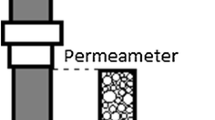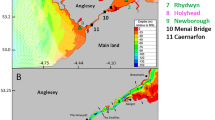Abstract
Many broadcast-spawning benthic invertebrates are subject to sperm limitation yet achieve high population densities, as for example dreissenid mussels (Dreissena polymorpha and Dreisssena bugensis) that were introduced into the Laurentian Great Lakes. The question remains whether biological or ecological/physical mechanisms reduce sperm limitation. Gamete dilution/longevity experiments were undertaken to determine whether dreissenid mussels are subject to sperm limitation, and computational fluid dynamic modeling was used to determine the potential influence of bottom roughness on sperm dilution in nature. Results indicated that dreissenid mussels may be sperm limited, but the extent to which sperm dilution affects them is lower than what was reported for other broadcast spawning invertebrates. Importantly, model mussel clusters influenced external fertilization by retaining sperm in downstream eddies but allowing downstream transport from one cluster to another. This, in addition to high sperm potency at low sperm concentrations, may help to explain the success of dreissenid mussels as invasive species.









Similar content being viewed by others
References
Ackerman JD (2002) Diffusivity in a marine macrophyte bed: implications for submarine pollination and dispersal. Am J Bot 89:1119–1127
Ackerman JD, Sim B, Nichols SJ, Claudi R (1994) A review of the early life history of zebra mussels (Dreissena polymorpha): comparisons with marine bivalves. Can J Zool 72:1169–1179
Ackerman JD, Loewen MR, Hamblin PF (2001) Benthic-pelagic coupling over a zebra mussel reef in western Lake Erie. Limnol Oceanogr 46:892–904
André C, Lindegarth M (1995) Fertilization efficiency and gamete viability of a sessile, free-spawning bivalve, Cerastoderma edule. Ophelia 43:215–227
Babcock R, Kessing J (1999) Fertilization biology of the abalone Haliotis laevigata: laboratory and field studies. Can J Fish Aquat Sci 56:1668–1678
Babcock RC, Mundy CN, Whitehead D (1994) Sperm diffusion models and in situ confirmation of long-distance fertilization in the free-spawning asteroid Acanthaster planci. Biol Bull 186:17–28
Baker MC, Tyler PA (2001) Fertilization success in the commercial gastropod Haliotis tuberculata. Mar Ecol Prog Ser 211:205–213
Benzie JAH, Dixon P (1994) The effects of sperm concentration, sperm:egg ratio, and gamete age on fertilization success in crown-of-thorns starfish (Acanthaster planci) in the laboratory. Biol Bull 186:139–152
Bishop JDD (1998) Fertilization in the sea: are the hazards of broadcast spawning avoided when free-spawned sperm fertilize retained eggs? Proc R Soc Lond B 265:725–731
Brady VJ, Cardinale BJ, Burton TM (1995) Zebra mussels in a costal marsh: the seasonal and spatial limits of colonization. J Great Lakes Res 21:587–593
Chang ER, Veeneklass RM, Buitenwerf R, Bakker JP, Bouma TJ (2008) To move or not to move: determinants of seed retention in a tidal marsh. Funct Ecol 22:720–727
Ciereszko A, Dabrowski K, Piros B, Kwasnik M, Glogowski J (2001) Characterization of zebra mussel (Dreissena polymorpha) sperm motility: duration of movement, effects of cations, pH and gossypol. Hydrobiologia 452:225–232
Colautti RI, MacIsaac HJ (2004) A neutral terminology to define ‘invasive’ species. Divers Distrib 10:135–141
Denny MW, Shibata M (1989) Consequences of surf-zone turbulence for settlement and fertilization. Am Nat 134:859–889
Devin S, Beisel JN (2007) Biological and ecological characteristics of invasive species: a gammarid study. Biol Invasions 9:13–24
Dong Y, Yao H, Lin Z, Zhu D (2011) The effects of sperm–egg ratios on polyspermy in the blood clam, Tegillarca granosa. Aquacult Res 42. doi:10.1111/j.1365-2109.2011.02799.x
Fallis LC, Stein KK, Lynn JW, Misamore MJ (2010) Identification and role of carbohydrates on the surface of gametes in the zebra mussel, Dreissena polymorpha. Biol Bull 218:61–74
Hardege JD, Ram JL, Bentley MG (1997) Activation of spawning in zebra mussels by algae-, cryptomonad-, and gamete-associated factors. Exp Biol Online 2:2
Hebert PDN, Muncaster BW, Mackie GL (1989) Ecological and genetic studies on Dreissena polymorpha (Pallas): a new mollusc in the Great Lakes. Can J Fish Aquat Sci 46:1587–1591
Hedges LV, Gurevitch J, Curtis PS (1999) The meta-analysis of response ratios in experimental ecology. Ecology 80:1150–1156
Inamdar MV, Kim T, Chung Y-K, Was AM, Xiang X, Wang C-W, Takayama S, Lastoskie CM, Thomas FIM, Sastry AM (2007) Assessment of sperm chemokinesis with exposure to jelly coats of sea urchin eggs and resact: a microfluidic experiment and numerical study. J Exp Biol 210:3805–3820
Lamare MD, Stewart BG (1998) Mass spawning by the sea urchin Evechinus chloroticus (Echinodermata: Echinoidea) in a New Zealand fiord. Mar Biol 132:135–140
Levitan DR (1993) The importance of sperm limitation to the evolution of egg size in marine invertebrates. Am Nat 141:517–536
Levitan DR (2005) Sex-specific spawning behavior and its consequences in an external fertilizer. Am Nat 165:682–694
Levitan DR, Young CM (1995) Reproductive success in large populations: empirical measures and theoretical predictions of fertilization in the sea biscuit Clypeaster rosaceus. J Exp Mar Biol Ecol 190:221–241
Levitan DR, Sewell MA, Chia F-S (1991) Kinetics of fertilization in the sea urchin Strongylocentrotus franciscanus: interaction of gamete dilution, age, and contact time. Biol Bull 181:371–378
Loewen MR, Ackerman JD, Hamblin PF (2007) Environmental implications of stratification and turbulent mixing in a shallow lake basin. Can J Fish Aquat Sci 64:43–57
Luetjens CM, Dorresteijn AWC (1995) Multiple, alternative cleavage patterns precede uniform larval morphology during normal development of Dreissena polymorpha (Mollusca, Lamellibranchia). Roux’s Arch Dev Biol 205:138–149
Manriquez PH, Hughes RN, Bishop JDD (2001) Age-dependent loss of fertility in water-borne sperm of the bryozoan Celleporella hyaline. Mar Ecol Prog Ser 224:87–92
Marsden JE, Lansky DM (2000) Substrate selection by settling zebra mussels, Dreissena polymorpha, relative to material, texture, orientation, and sunlight. Can J Zool 78:787–793
Marshall DJ, Bolton TF (2007) Sperm release strategies in marine broadcast spawners: the costs of releasing sperm quickly. J Exp Biol 210:3720–3727
Marshall DJ, Semmens D, Cook C (2004) Consequences of spawning at low tide: limited gamete dispersal for a rockpool anemone. Mar Ecol Prog Ser 266:135–142
McNichols KA, Mackie GL, Ackerman JD (2011) Host fish quality may explain the status of endangered Epioblasma torulosa rangiana and Lampsilis fasciola (Bivalvia: Unionidae) in Canada. J N Am Benthol Soc 30:60–70
Miller RL, Mojares JJ, Ram JL (1994) Species-specific sperm attraction in the zebra mussel, Dreissena polymorpha, and the quagga mussel, Dreissena bugensis. Can J Zool 72:1764–1770
Misamore MJ, Lynn JW (2000) Role of cytoskeleton in sperm entry during fertilization in the freshwater bivalve Dreissena polymorpha. Biol Bull 199:144–156
Misamore M, Silverman H, Lynn JW (1996) Analysis of fertilization and polyspermy in serotonin-spawned eggs of the zebra mussel, Dreissena polymorpha. Mol Reprod Dev 43:205–216
Nichols SJ, Black MG (1994) Identification of larvae: the zebra mussel (Dreissena Polymorpha), quagga mussel (Dreissena rosteriformis bugensis), and Asian clam (Corbicula fluminea). Can J Zool 72:406–417
Oliver J, Babcock R (1992) Aspects of the fertilization ecology of broadcast spawning corals: sperm dilution effects and in situ measurements of fertilization. Biol Bull 183:409–417
Pearson GA, Serrao EA, Brawley SH (1998) Control of gamete release in flucoid algae: sensing hydrodynamic conditions via carbon acquisition. Ecology 79:1725–1739
Pennington JT (1985) The ecology of fertilization of echinoid eggs: the consequences of sperm dilution, adult aggregation, and synchronous spawning. Biol Bull 169:417–430
Ram JL, Palazzo SM (2008) Globalization of an Aquatic Pest: Economic Costs, Ecological Outcomes, and Positive Applications of Zebra Mussel Invasions and Expansions. Geogr Compass 2:1755–1776
Ram JL, Crawford GW, Walker JU, Mojares JJ, Patel N, Fong PP, Kyozuka K (1993) Spawning in the zebra mussel (Dreissena polymorpha): activation by internal or external application of serotonin. J Exp Zool 265:587–598
Reidel IH, Kruse K, Howard J (2005) A self-organized vortex array of hydrodynamically entrained sperm cells. Science 309:300–303
Schindler RJ, Ackerman JD (2010) The environmental hydraulics of turbulent boundary layers. In: Mihailovic DT, Gualtieri C (eds) Advances in Environmental Fluid Mechanics. World Scientific, London, pp 87–126
Sprung M (1993) The other life: an account of present knowledge of the larval phase of Dreissena polymorpha. In: Nalepa TF, Schloesser D (eds) Zebra mussels: biology, impacts, control. Lewis Publishers, Boca Raton, pp 39–53
Stoeckel JA, Padilla DK, Schneider DW, Rehmann CR (2004) Laboratory culture of Dreissena polymorpha larvae; spawning success, adult fecundity, and larval mortality patterns. Can J Zool 82:1436–1443
Stoeckmann A (2003) Physiological energetics of Lake Erie dreissenid mussels: a basis for the displacement of Dreissena polymorpha by Dreissena bugensis. Can J Fish Aquat Sci 60:126–134
Styan CA, Kupriyanova E, Havenhand JN (2008) Barriers to cross-fertilization between populations of a widely dispersed polychaete species are unlikely to have arisen through gametic compatibility arms-races. Evol 62:3041–3055
Wahle RA, Peckham SH (1999) Density-related reproductive trade-offs in the green sea urchin, Strongylocentrotus droebachiensis. Mar Biol 134:127–137
Wright DA, Setzler-Hamilton EM, Magee JA, Kennedy VS, McIninch SP (1996) Effect of salinity and temperature on survival and development of young zebra (Dreissena polymorpha) and quagga (Dreissena bugensis) mussels. Estuaries 19:619–628
Yund PO, Meidel SK (2003) Sea urchin spawning in the benthic boundary layer: are eggs fertilized before advecting away from females? Limnol Oceanogr 48:795–801
Acknowledgments
The authors would like to thank Dr. G. Nishihara, P. Ragaz, K. McNichols, and B. Hunt for their assistance in the laboratory and field. We also thank several anonymous reviews for their comments on an earlier draft. This work was funded by a NSERC Discovery Grant to JDA.
Author information
Authors and Affiliations
Corresponding author
Rights and permissions
About this article
Cite this article
Quinn, N.P., Ackerman, J.D. Biological and ecological mechanisms for overcoming sperm limitation in invasive dreissenid mussels. Aquat Sci 74, 415–425 (2012). https://doi.org/10.1007/s00027-011-0237-0
Received:
Accepted:
Published:
Issue Date:
DOI: https://doi.org/10.1007/s00027-011-0237-0




